Fresh and charming Assia Noris (1912-1998) is best remembered as the star of several 1930s romantic comedies directed by Mario Camerini and co-starring Vittorio De Sica. Although Russian-born, she was nicknamed Italy's sweetheart.
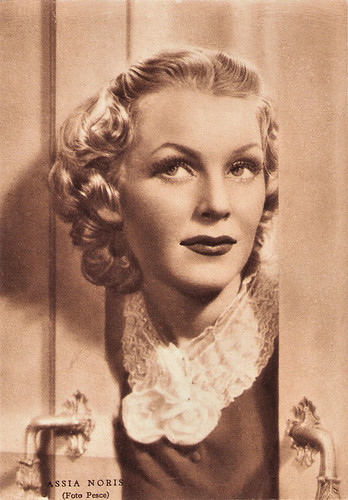
Italian postcard by Rizzoli EC., Milano, 1938-XVI. Photo: Pesce.
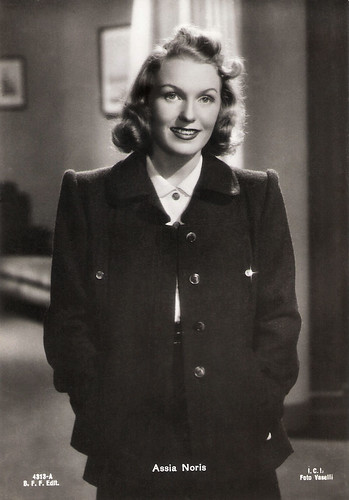
Italian postcard by B.F.F. Edit, no. 413-A. Photo: I.C.I. / Vaselli.
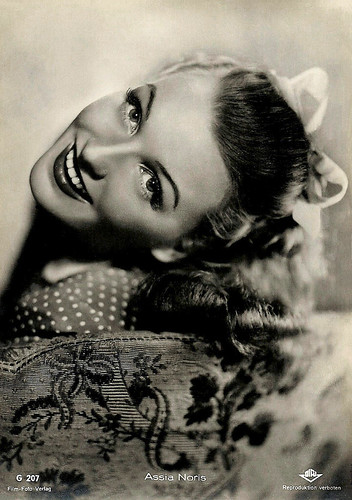
German postcard by Film-Foto-Verlag, no. G 207, 1941-1944. Photo: Difu.
Assia Noris was born Anastasia Noris von Gerzfeld in St. Petersburg, Russia, in 1912. Her father was a German official, her mother was from Ukraine.
After the Russian Revolution the family fled first to France, then to Italy in 1929. That year Assia also married count Gastone d’Assia, whose last name she would use as stage name, even if he was only the first of her five husbands.
In 1933 Assia Noris made her screen début in Tre uomini in frac/I Sing for You Alone, the Italian version of the French film Trois hommes en habit. Both versions were directed by Mario Bonnard and starred opera singer Tito Schipa.
In 1935-1936 she also played in both the French and the Italian version of Bonnard’s La marcia nuziale/La marche nuptiale (Mario Bonnard, 1936).
Noris’ fame, however, is linked to her performances in the comedies by Mario Camerini, with whom she had an affair from 1936 on, dropping her former lover Roberto Rossellini – whom she presumably married for a very short time. At that time Rossellini was a penniless playboy and working as an editor, Camerini was an acclaimed director.
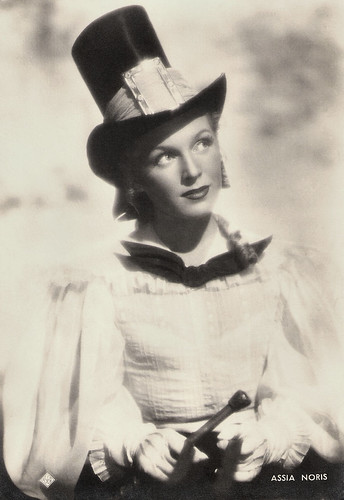
Italian postcard by A. Scarmiglia Ed., Roma (ASER), no. 166. Photo: Vaselli.

Italian postcard by Ed. Rizzoli, Milano, 1936.
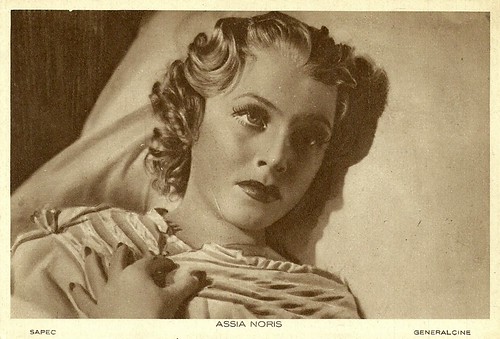
Italian postcard. Photo: SAPEC / Generalcine. Assia Noris in Voglio vivere con Letizia (Camillo Mastrocinque, 1938).
Assia Noris’ male co-partner in the Camerini comedies was heartthrob Vittorio De Sica. Often she played the honest lower or middle class girl, such as the circus girl Anna who has an affair with a millionaire who goes undercover as a bum in Darò un milione/I'll Give a Million (Mario Camerini, 1935)
Noris played the governess Lauretta who likes the newspaper vendor Gianni but dislikes the snob Max, not knowing they are one and the same man in Il signor Max/Mister Max (Mario Camerini, 1937). She is also the shopping girl in a department store who first dislikes, then falls in love with the new assistant and chauffeur, who becomes a local hero, in I Grandi magazzini/Department Store (Mario Camerini, 1939).
In all of these films De Sica pretends to be somebody else: a simple man while being millionnaire in Darò un milione, a millionaire while being a simple man in Il signor Max, while Assia Noris remains the honest, simple girl.
This pretense of a second character Noris played herself too in Batticuore/Heartbeat (Mario Camerini, 1939), in which she is a pickpocketing girl hired by a diplomat (John Lodge) but considered a baroness by others. She also played one and the same person but in three different stages of her life in Camerini’s Una romantica avventura/A Romantic Adventure (Mario Camerini, 1940) opposite Gino Cervi.
Guy Bellinger describes her star persona at IMDb: "Fresh and charming, she drew lots of fans into theaters. Not that the comedies she played in were masterpieces: they were in fact harmless and a bit artificial but constituted welcome escapism from the strange times the Italians were living. Not that Assia Noris was the greatest actress ever either: she never really changed face expressions, when she was supposed to cry she shed crocodile tears plus she could not go beyond the superficiality of the characters she was given to play. But how sizzling she was, how cute she was and what beautiful costumes and hats she wore!"
Noris demonstrated she could play the diva part as well in the comedy Dora Nelson (Mario Soldati, 1939), in which she really plays two characters opposite Carlo Ninchi: a bitchy Russian film star and as a simple girl replacing the impossible star, both at the Cinecittà studios as well as at home. Likeness causes problems but also offers attractive solutions.
During the war years Noris was a bit fed up with playing the ‘ingénue’, the fiancée; so she now also played dramatic roles as in Un colpo di pistola/A Pistol Shot (Renato Castellani, 1942) with Fosco Giachetti, and Una storia d’amore/Love Story (Mario Camerini, 1942) with Piero Lulli. With her romanticism and her angelic looks, she represented the Italian woman ‘par excellence’ for over a decade, despite her overacting, her foreign accent and her rather Northern European beauty.
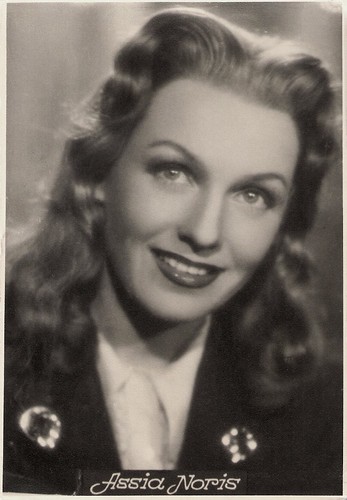
Italian postcard by Mimosa.
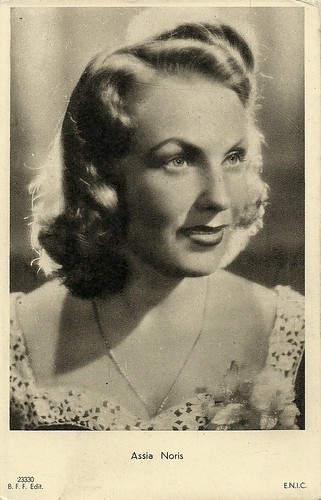
Italian postcard by B.F.F. Edit (Ballerini & Fratini Editori, Firenze), no. 2333. Photo: E.N.I.C.
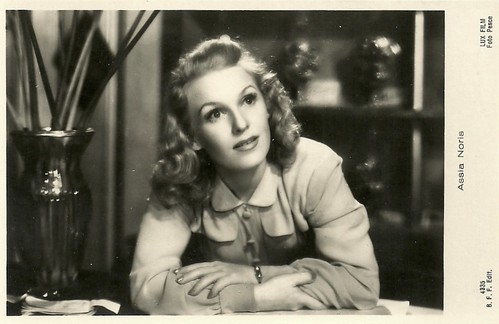
Italian postcard by B.F.F. Edit (Ballerini & Fratini Editori, Firenze), no. 4335. Photo: Lux Film / Foto Pesce.
Assia Noris was not a bit afraid to cause a scandal, being the first woman in Italy to wear a bikini in public, to great jealousy of rival actresses Doris Duranti and Clara Calamai.
One of her key moments in life was her encounter with Adolph Hitler, whom she described as a snowman with fake nose, eyes and moustache. While spitting her in the face, Hitler offered her to play at Ufa, which she gently declined, causing general embarrassment.
When war came on in 1940, Noris secured herself against her foreignness by marrying Mario Camerini, Italianizing her. The marriage ended in quarrels, though, in 1943.
Noris tried her luck in France with two films, Le voyageur de la Toussaint/The Traveller of All Saints' Day (Louis Daquin, 1943) with Jules Berry, and Le capitaine Fracasse/Captain Fracasse (Abel Gance, 1943) featuring Fernand Gravey, but both were unsuccessful.
When the war was over, Noris’ career was over as well. People did not blame her for her career under Benito Mussolini; her anti-fascism was known, but her type was traded now for the more populist face of Anna Magnani and of course those of the non-professional actors and actresses of the Neorealist cinema.
Noris did two more films in 1945, and one in 1951, but none were successes. She tried her luck on stage but this wasn’t a success as well. In 1961 film director Carlo Lizzani gave her one last lead in his comedy La Celestina P... R... (Carlo Lizzani, 1965) with Venantino Venantini.
For years Noris lived in Egypt with her fifth husband, the Egyptian impresario Antoine 'Tony' Habib – he came after D’Assia, Rosselini, Camerini, and the British official Jacob Pelster.
In 1998 Assia Noris died in a hospital in San Remo, Italy, after a short illness.
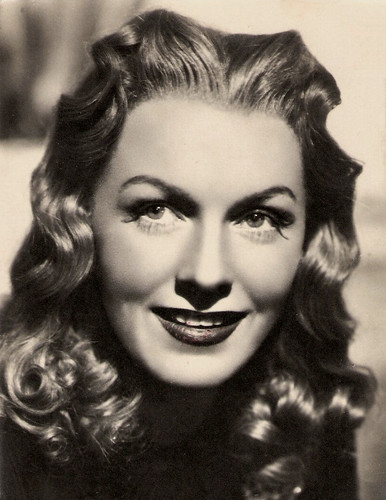
Italian postcard by A. Scarmiglia Ed., Roma (ASER), no. 43. Photo: Vaselli / Juventus.
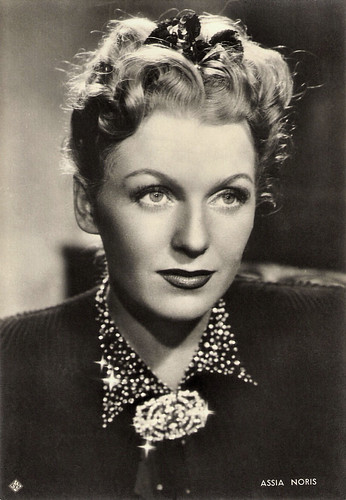
Italian postcard by A. Scarmiglia Ed., Roma (ASER), no. 111.
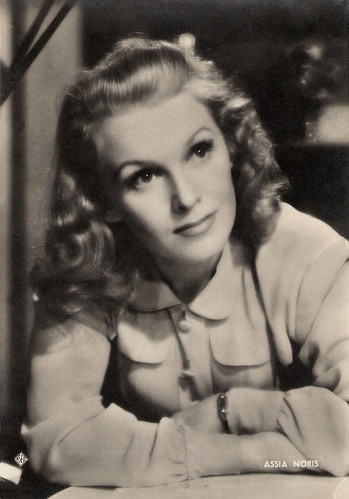
Italian postcard by A. Scarmiglia Ed., Roma (ASER), no. 222. Photo: Pesce / Lux Film.
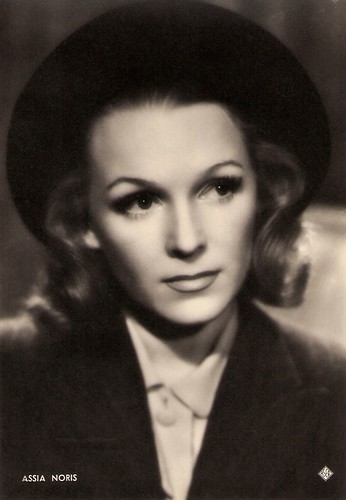
Italian postcard by A. Scarmiglia Ed., Roma (ASER), no. 237.
Sources: Guy Bellinger (IMDb), CineArtistes (French), Wikipedia (Italian), and IMDb.

Italian postcard by Rizzoli EC., Milano, 1938-XVI. Photo: Pesce.

Italian postcard by B.F.F. Edit, no. 413-A. Photo: I.C.I. / Vaselli.

German postcard by Film-Foto-Verlag, no. G 207, 1941-1944. Photo: Difu.
Five Husbands
Assia Noris was born Anastasia Noris von Gerzfeld in St. Petersburg, Russia, in 1912. Her father was a German official, her mother was from Ukraine.
After the Russian Revolution the family fled first to France, then to Italy in 1929. That year Assia also married count Gastone d’Assia, whose last name she would use as stage name, even if he was only the first of her five husbands.
In 1933 Assia Noris made her screen début in Tre uomini in frac/I Sing for You Alone, the Italian version of the French film Trois hommes en habit. Both versions were directed by Mario Bonnard and starred opera singer Tito Schipa.
In 1935-1936 she also played in both the French and the Italian version of Bonnard’s La marcia nuziale/La marche nuptiale (Mario Bonnard, 1936).
Noris’ fame, however, is linked to her performances in the comedies by Mario Camerini, with whom she had an affair from 1936 on, dropping her former lover Roberto Rossellini – whom she presumably married for a very short time. At that time Rossellini was a penniless playboy and working as an editor, Camerini was an acclaimed director.

Italian postcard by A. Scarmiglia Ed., Roma (ASER), no. 166. Photo: Vaselli.

Italian postcard by Ed. Rizzoli, Milano, 1936.

Italian postcard. Photo: SAPEC / Generalcine. Assia Noris in Voglio vivere con Letizia (Camillo Mastrocinque, 1938).
Angelic Looks
Assia Noris’ male co-partner in the Camerini comedies was heartthrob Vittorio De Sica. Often she played the honest lower or middle class girl, such as the circus girl Anna who has an affair with a millionaire who goes undercover as a bum in Darò un milione/I'll Give a Million (Mario Camerini, 1935)
Noris played the governess Lauretta who likes the newspaper vendor Gianni but dislikes the snob Max, not knowing they are one and the same man in Il signor Max/Mister Max (Mario Camerini, 1937). She is also the shopping girl in a department store who first dislikes, then falls in love with the new assistant and chauffeur, who becomes a local hero, in I Grandi magazzini/Department Store (Mario Camerini, 1939).
In all of these films De Sica pretends to be somebody else: a simple man while being millionnaire in Darò un milione, a millionaire while being a simple man in Il signor Max, while Assia Noris remains the honest, simple girl.
This pretense of a second character Noris played herself too in Batticuore/Heartbeat (Mario Camerini, 1939), in which she is a pickpocketing girl hired by a diplomat (John Lodge) but considered a baroness by others. She also played one and the same person but in three different stages of her life in Camerini’s Una romantica avventura/A Romantic Adventure (Mario Camerini, 1940) opposite Gino Cervi.
Guy Bellinger describes her star persona at IMDb: "Fresh and charming, she drew lots of fans into theaters. Not that the comedies she played in were masterpieces: they were in fact harmless and a bit artificial but constituted welcome escapism from the strange times the Italians were living. Not that Assia Noris was the greatest actress ever either: she never really changed face expressions, when she was supposed to cry she shed crocodile tears plus she could not go beyond the superficiality of the characters she was given to play. But how sizzling she was, how cute she was and what beautiful costumes and hats she wore!"
Noris demonstrated she could play the diva part as well in the comedy Dora Nelson (Mario Soldati, 1939), in which she really plays two characters opposite Carlo Ninchi: a bitchy Russian film star and as a simple girl replacing the impossible star, both at the Cinecittà studios as well as at home. Likeness causes problems but also offers attractive solutions.
During the war years Noris was a bit fed up with playing the ‘ingénue’, the fiancée; so she now also played dramatic roles as in Un colpo di pistola/A Pistol Shot (Renato Castellani, 1942) with Fosco Giachetti, and Una storia d’amore/Love Story (Mario Camerini, 1942) with Piero Lulli. With her romanticism and her angelic looks, she represented the Italian woman ‘par excellence’ for over a decade, despite her overacting, her foreign accent and her rather Northern European beauty.

Italian postcard by Mimosa.

Italian postcard by B.F.F. Edit (Ballerini & Fratini Editori, Firenze), no. 2333. Photo: E.N.I.C.

Italian postcard by B.F.F. Edit (Ballerini & Fratini Editori, Firenze), no. 4335. Photo: Lux Film / Foto Pesce.
Scandalous Bikini
Assia Noris was not a bit afraid to cause a scandal, being the first woman in Italy to wear a bikini in public, to great jealousy of rival actresses Doris Duranti and Clara Calamai.
One of her key moments in life was her encounter with Adolph Hitler, whom she described as a snowman with fake nose, eyes and moustache. While spitting her in the face, Hitler offered her to play at Ufa, which she gently declined, causing general embarrassment.
When war came on in 1940, Noris secured herself against her foreignness by marrying Mario Camerini, Italianizing her. The marriage ended in quarrels, though, in 1943.
Noris tried her luck in France with two films, Le voyageur de la Toussaint/The Traveller of All Saints' Day (Louis Daquin, 1943) with Jules Berry, and Le capitaine Fracasse/Captain Fracasse (Abel Gance, 1943) featuring Fernand Gravey, but both were unsuccessful.
When the war was over, Noris’ career was over as well. People did not blame her for her career under Benito Mussolini; her anti-fascism was known, but her type was traded now for the more populist face of Anna Magnani and of course those of the non-professional actors and actresses of the Neorealist cinema.
Noris did two more films in 1945, and one in 1951, but none were successes. She tried her luck on stage but this wasn’t a success as well. In 1961 film director Carlo Lizzani gave her one last lead in his comedy La Celestina P... R... (Carlo Lizzani, 1965) with Venantino Venantini.
For years Noris lived in Egypt with her fifth husband, the Egyptian impresario Antoine 'Tony' Habib – he came after D’Assia, Rosselini, Camerini, and the British official Jacob Pelster.
In 1998 Assia Noris died in a hospital in San Remo, Italy, after a short illness.

Italian postcard by A. Scarmiglia Ed., Roma (ASER), no. 43. Photo: Vaselli / Juventus.

Italian postcard by A. Scarmiglia Ed., Roma (ASER), no. 111.

Italian postcard by A. Scarmiglia Ed., Roma (ASER), no. 222. Photo: Pesce / Lux Film.

Italian postcard by A. Scarmiglia Ed., Roma (ASER), no. 237.
Sources: Guy Bellinger (IMDb), CineArtistes (French), Wikipedia (Italian), and IMDb.
No comments:
Post a Comment